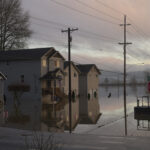More than 700 temporary buildings are reportedly helping Mississippi communities carry out the day-to-day business of local government and schools while permanent facilities damaged or destroyed by Hurricane Katrina are being repaired or replaced.
Tuesday, in a ceremony at the Long Beach Fire Department, the U.S. Department of Homeland Security’s Federal Emergency Management Agency (FEMA) and the U.S. Army Corps of Engineers (USACE) marked the completion of work to place 726 portable structures, including the temporary garage and structure to house local firefighters and their equipment.
“By assigning this $100 million project to the Corps within days after Katrina came ashore, FEMA ensured schools could open with temporary classrooms in place and communities could get back to work,” said Nick Russo, federal coordinating officer for the Mississippi disaster recovery. “While this Corps assignment is complete, FEMA will continue to work with the Mississippi Emergency Management Agency on permanent repairs and restoration of facilities.”
The mission assignment helped restore critical local government services in Mississippi’s six southern counties where 233 modular buildings are standing in for fire and police stations, state and local government offices, ports, medical clinics and legal facilities.
“The Corps really appreciates being able to serve the nation and the State of Mississippi by helping rebuild its government and education systems,” said Col. Anthony Vesay, commander of the Mississippi Task Force Hope hurricane recovery mission. “We are excited to see these hard hit communities, many of them our own family and friends, regain a degree of stability and sense of normalcy in their lives.”
The 493 portable classrooms are in use at 303 schools located in nine counties (Copiah, Forrest, Hancock, Harrison, Jackson, Jasper, Lamar, Marion, and Pearl River). The temporary school buildings were constructed with wood frames, insulation and aluminum siding. Each classroom includes whiteboards and bulletin boards as well as carpeting, windows, heat and air conditioning. Most units have wood ramps and decks and some have restrooms.
Was this article valuable?
Here are more articles you may enjoy.

 Insurance AI Demo Day Calendar Announced
Insurance AI Demo Day Calendar Announced  Zillow Deleting Climate Risk Scores Reveals Limits of Flood, Fire Data
Zillow Deleting Climate Risk Scores Reveals Limits of Flood, Fire Data  Trump Sues BBC for $10 Billion Over Documentary Edit
Trump Sues BBC for $10 Billion Over Documentary Edit  Pacific Northwest Braces for Even More Flooding Rain This Week
Pacific Northwest Braces for Even More Flooding Rain This Week 